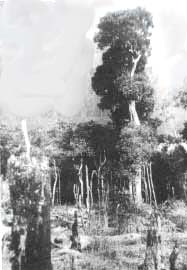Shattering myths
 MYTH: The only way you can make money out of a forest is by exploiting its biodiversity, cutting and logging the trees. Fact: there is more to the story than just that. And this is a point that the Iwokrama International Rain Forest Programme, the world's largest project in sustainable management of pristine Amazon rainforest, is about to prove. It is a unique project with a strong message of hope for many developing nations with forest wealth.
MYTH: The only way you can make money out of a forest is by exploiting its biodiversity, cutting and logging the trees. Fact: there is more to the story than just that. And this is a point that the Iwokrama International Rain Forest Programme, the world's largest project in sustainable management of pristine Amazon rainforest, is about to prove. It is a unique project with a strong message of hope for many developing nations with forest wealth.
The programme, spanning some 3,60,000 hectares (ha) of tropical forests in the small South American nation of Guyana, is all set to prove that these forests could provide economic benefits without destroying their biodiversity. It operates on the premise that sustainable development can improve the quality of human life while working within the carrying capacity of the supporting ecosystem.
"It is now widely recognised that more than 60 per cent of Earth's terrestrial biodiversity occurs in the rainforests," says M S Swaminathan, chairperson, board of trustees of the Iwokrama International Centre for Rainforest Conservation and Development. The centre was set up in Guyana in 1996 as an autonomous institution governed by an international board of trustees.
The programme began in 1990, when Guyana, in an extraordinary gesture, dedicated 3,60,000 ha of rainforest - pristine, unexploited and surrounded by rivers - to demonstrate how the forests could bring monetary benefits without entailing overexploitation of their biodiversity. The pledge was made at the 1989 Commonwealth Heads of Governments meeting at Kuala Lumpur, Malaysia.
Situated some 300 km south of Guyana's capital Georgetown, half of the Iwokrama forest is maintained as a wilderness preserve, to provide a reference standard of ecological processes and interactions and biological diversity. Traditional uses by the sparse indigenous communities in America will be permitted together with nondestructive observational research. The other half is allocated to sustainable utilisation of its multiple forest resources. The project aims to define the extent to which sustainable utilisation of these resources is compatible with their conservation and to determine the impact of such utilisation on their biodiversity.
Iwokrama is making a special effort to learn and document the traditional knowledge and management practices regarding forest goods and services by the American-Indian communities who have been using the forest's resources. The project is committed to assisting these communities to achieve sustainable development and to protect their intellectual property rights. Training opportunities for employment and sale of locally made foodstuffs and forest products are provided to them through the Iwokrama field station.
The project is divided into three thematic programmes sustainable management of the tropical rainforest, conservation and utilisation of biodiversity, and sustainable human development and two overlapping programmes: forestry research, information and communication. "Iwokrama stands as a shining example of the steps taken by a small country with the help of the international organisations (the United Nations and the Common wealth) to convert the vision articulated in Agenda 21 at Rio six years ago into grassroots level achievement," Swaminathan says.
